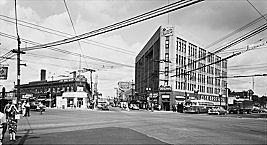| Entries |
| S |
|
Six Corners
|

|
In 1914 Jacob Derx began publishing the Weekly Bulletin, a local paper carrying neighborhood news and advertisements of area merchants. Six Corners became a booming retail center.
The architecturally elaborate Portage Theater was built in the 1920s. People came in droves to see a feature movie and listen to the theater's organ. In 1938, major retailer Sears, Roebuck & Co. became an anchor. By the 1980s, there were 150 stores at Six Corners. National chains had blended with established and family businesses into the 1990s.
Bibliography
Fitzgerald, Michael. “Six Corners, 150 Stores.”
Chicago Sun-Times,
“Cityscape” (supplement), August 1988.
Howard, T. J. “A Three-dimensional Success: Six Corners' Commerce Is Built on a Strong Residential Foundation.”
Chicago Tribune,
March 10, 1983.
The Electronic Encyclopedia of Chicago © 2005 Chicago Historical Society.
The Encyclopedia of Chicago © 2004 The Newberry Library. All Rights Reserved. Portions are copyrighted by other institutions and individuals. Additional information on copyright and permissions.
The Encyclopedia of Chicago © 2004 The Newberry Library. All Rights Reserved. Portions are copyrighted by other institutions and individuals. Additional information on copyright and permissions.